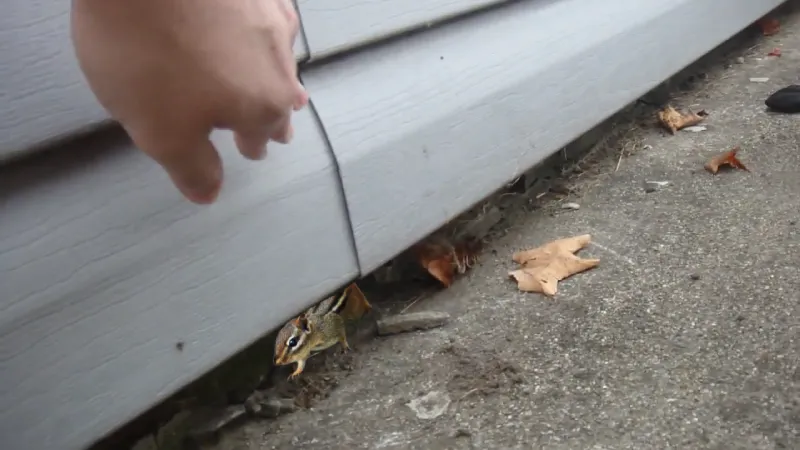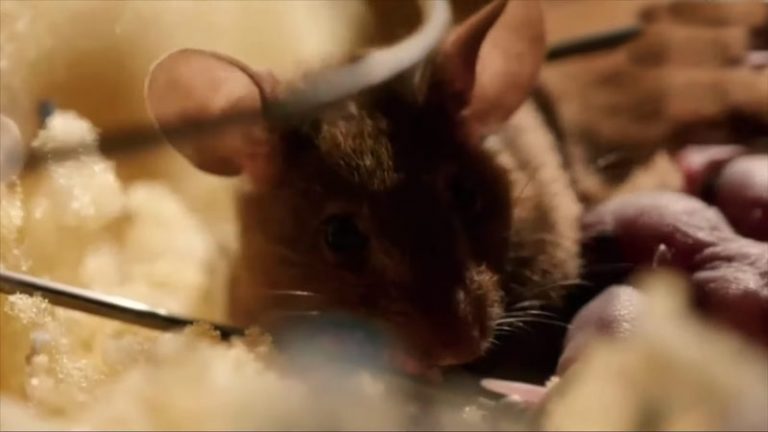Chipmunk Behind Siding [What to Do?]

Chipmunks are small, burrowing rodents that can be found in a variety of habitats, including forests, grasslands, and suburban areas. They are known for their distinctive chip-chip call, their love of seeds and nuts, and their habit of gathering food and storing it in their burrows for the winter.
Chipmunks can cause damage to gardens and other plants, and may burrow around the foundations of homes. In this article, we will discuss the signs of a chipmunk infestation, and provide some solutions for getting rid of chipmunks in and around your home.
You'll Learn About
Why are Chipmunks Behind Siding?
There are many reasons why chipmunks are behind the siding. Here are the top reasons:
- Shelter: Chipmunks may burrow behind the siding to create a cozy shelter for themselves.
- Protection from predators: Siding provides protection from predators that may try to catch and eat the chipmunks.
- Access to food: Chipmunks may be attracted to the insects, plants, and other sources of food found near the siding.
- Availability of materials: Siding may provide chipmunks with the materials they need to build their burrows.
- Warmth in cold weather: Burrowing behind siding may help chipmunks stay warm in cold weather.
- Coolness in hot weather: In hot weather, chipmunks may burrow behind the siding to escape the heat.
- Location: Siding is often located near the ground, which is where chipmunks typically live.
- Ease of burrowing: Siding may be easier for chipmunks to burrow through than other materials, such as concrete or stone.
- Lack of other options: Chipmunks may burrow behind siding if they cannot find any other suitable locations to build their burrows.
- Opportunistic behavior: Chipmunks are opportunistic animals and will take advantage of any available resources, including siding, to build their burrows.
Are Chipmunks Bad to Have Around Your House? What Are the Signs?
- Damage to plants: One of the most common signs of a chipmunk infestation is damage to plants in the yard or garden. Chipmunks may eat the leaves, stems, and roots of plants, and may also dig up and eat bulbs, fruits, and seeds.
- Footprints in the dirt: Chipmunks have four toes on their front feet and five toes on their hind feet. If you see small footprints in the dirt around your house, garden, or shed, it may be a sign of a chipmunk infestation.
- Cracked sidewalks: Chipmunks are known for their burrowing habits, and may dig tunnels underneath sidewalks, patios, decks, and other structures. If you notice cracks or holes in your sidewalks, it may be a sign that chipmunks are burrowing underneath them.
- House foundation problems: Chipmunks may burrow around the foundation of your house, which can cause structural damage and may even compromise the stability of your home. If you notice cracks, holes, or other signs of damage to your house foundation, it may be due to chipmunks.
- High-pitched chirping noises: Chipmunks make a distinctive high-pitched chirping noise that sounds like “chip chip.” If you hear this noise coming from inside your house, it may be a sign that you have a chipmunk problem.
- Presence of burrows: Chipmunks are burrowing animals, and their burrows are often visible near their homes. If you see holes, tunnels, or mounds of dirt in your yard, it may be a sign that chipmunks are living there.
- Sightings of chipmunks: Of course, the most obvious sign of a chipmunk infestation is the presence of chipmunks themselves. If you see chipmunks in your yard or around your house, it is likely that they have established a home there.
- Gnawed objects: Chipmunks have sharp teeth and are known for their ability to chew through a variety of materials. If you notice that objects in your yard, such as birdhouses, tree trunks, or wooden fences, have been gnawed or chewed on, it may be a sign of a chipmunk infestation.
- Damage to gardens: Chipmunks may damage gardens by eating plants, digging holes, and leaving droppings. If you notice that your garden is not looking as healthy as it should, or that plants are disappearing or being damaged, it may be due to chipmunks.
- Presence of chipmunk droppings: Chipmunks produce small, oblong droppings that are dark in color and have a shiny, smooth appearance. If you see these droppings in your yard or around your house, it may be a sign that chipmunks are living there. These droppings can also be a health hazard, as they may carry disease-causing bacteria.
How Do You Get Chipmunks Out of the Siding?
Using a live trap
Tools needed: live trap, bait (such as seeds, nuts, or fruit)
Step-by-step guide:
- Place the live trap in an area where you have seen chipmunks, or where you suspect they may be living.
- Bait the trap with seeds, nuts, or fruit.
- Check the trap regularly, and if you have caught a chipmunk, carefully transfer it to a secure container.
- Once the chipmunk is in the container, take it a few miles away from your home and release it in a suitable location.
Sealing off access points
Tools needed: caulk, wire mesh, sealant
Step-by-step guide:
- Inspect the siding of your home, looking for any holes, cracks, or gaps that chipmunks may be used to access the inside.
- Use caulk or sealant to fill in any holes or gaps you find.
- For larger gaps or holes, cut a piece of wire mesh to size and secure it over the opening using screws or adhesive.
- Repeat the process until all potential access points are sealed off. This should prevent chipmunks from entering the siding of your home.
Installing a physical barrier
Tools needed: L-shaped footer, screws, or adhesive
Step-by-step guide:
- Measure the area around the base of your home where the siding meets the ground.
- Cut the L-shaped footer to size, allowing for an extra few inches on each side.
- Use screws or adhesive to attach the footer to the siding, making sure it is securely in place.
- The L-shaped footer should extend out into the ground, creating a physical barrier that will prevent chipmunks from burrowing underneath the siding.
Using a repellent
Tools needed: repellent spray, gloves
Step-by-step guide:
- Choose a repellent spray that is specifically designed for chipmunks.
- Put on gloves to protect your hands from the repellent.
- Spray the repellent around the base of your home, focusing on areas where the siding meets the ground.
- Be careful to avoid spraying the repellent directly onto plants, as it may damage them.
- Reapply the repellent every few weeks, as the effects will wear off over time.
Note: Before using any repellent, be sure to read and follow the instructions on the label carefully, and take necessary safety precautions.
Using a repellent scent
Tools needed: cotton balls, essential oils (such as peppermint or citronella)
Step-by-step guide:
- Choose an essential oil that is known to repel chipmunks, such as peppermint or citronella.
- Dilute the essential oil with water according to the instructions on the bottle.
- Soak cotton balls in the diluted essential oil.
- Place the cotton balls in areas where you have seen chipmunks, or where you suspect they may be living.
- Replace the cotton balls every few days, as the scent will fade over time.
Using a predator decoy
Tools needed: predator decoy (such as a fake owl or snake)
Step-by-step guide:
- Choose a predator decoy that is known to be effective against chipmunks, such as a fake owl or snake.
- Place the decoy in an area where you have seen chipmunks, or where you suspect they may be living.
- Move the decoy around periodically to create the illusion of a real predator.
- Be sure to remove the decoy when it is no longer needed, as it may attract other animals to your yard.
Using a commercial rodent repellent
Tools needed: commercial rodent repellent, gloves
Step-by-step guide:
- Choose a commercial rodent repellent that is designed explicitly for chipmunks.
- Put on gloves to protect your hands from the repellent.
- Follow the instructions on the label to apply the repellent around the base of your home, focusing on areas where the siding meets the ground.
- Be careful to avoid applying the repellent directly onto plants, as it may damage them.
- Reapply the repellent every few weeks, as the effects will wear off over time.
Note: Before using any repellent, be sure to read and follow the instructions on the label carefully, and take necessary safety precautions.
Using a commercial rodent trap
Tools needed: commercial rodent trap, bait (such as seeds, nuts, or fruit)
Step-by-step guide:
- Choose a commercial rodent trap that is designed explicitly for chipmunks.
- Bait the trap with seeds, nuts, or fruit.
- Place the trap in an area where you have seen chipmunks, or where you suspect they may be living.
- Check the trap regularly, and if you have caught a chipmunk, carefully transfer it to a secure container.
- Once the chipmunk is in the container, take it a few miles away from your home and release it in a suitable location.
Note: Be sure to use a humane trap that will not cause the chipmunk any harm. Also, be sure to check local laws and regulations regarding the trapping and relocation of chipmunks.
FAQs
Q: Do chipmunks carry diseases?
A: Chipmunks can carry diseases, such as Lyme disease and rabies, that can be transmitted to humans and other animals. It is important to take precautions to avoid coming into contact with chipmunks and their droppings and to seek medical attention if you have been bitten or scratched by a chipmunk.
Q: Can chipmunks climb trees?
A: Yes, chipmunks are excellent climbers and are often seen climbing trees in search of food, shelter, or a mate. They have strong legs and claws that allow them to climb up and down trees with ease.
Q: Can chipmunks swim?
A: Chipmunks are not strong swimmers, but they can swim if they need to. They may swim across small bodies of water, such as streams or ponds, in order to reach food or escape from predators.
Q: Can chipmunks be kept as pets?
A: Chipmunks are wild animals and are not suitable for keeping as pets. They can be difficult to tame and may bite or scratch if they feel threatened. In addition, it is illegal in many areas to keep chipmunks as pets. It is best to admire these creatures from a distance and leave them in their natural habitat.
Also Read – Can You Put Out A Duraflame Log And Reuse It?
Final Words
Chipmunks are small, burrowing rodents that can be found in many different habitats. They are known for their distinctive chip-chip call, their love of seeds and nuts, and their habit of gathering food and storing it in their burrows for the winter.
If you have a chipmunk problem in your yard, you may see evidence of damage to plants, footprints in the dirt, and burrows around the foundation of your home. To get rid of chipmunks, you can try using a live trap, sealing off access points, installing a physical barrier, using a repellent, or using a predator decoy.
Be sure to read and follow the instructions on any products you use, and take necessary safety precautions.



